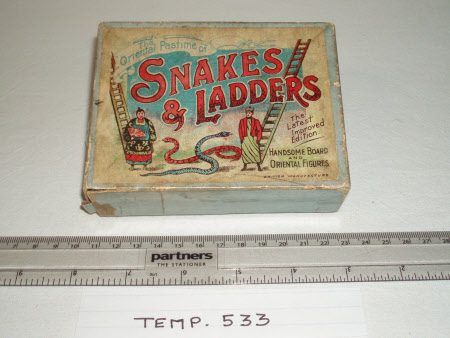Untitled
Category
Sports equipment, games and pastimes
Date
Unknown
Materials
Cardboard, wood, ivory or bone, metal and paper
Measurements
Box - 120 mm (length); 90 mm (width); 32 mm (depth), Each piece inside box (min) - 6 mm (height), Each piece inside box (max) - 62 mm (height)
Place of origin
Great Britain
Order this imageCollection
Sudbury Hall Museum of Childhood, Derbyshire
NT 665287
Summary
A box for Snakes and Ladders, one side broken. The box contains: (1) one blue wooden dice holder with turned decoration at the top and bottom; (2) six bone or ivory dice; (3) six painted lead figures riding bicycles, three are headless and one of the figures is missing; (4) six green printed labels with 'Bell' or 'Whistle'; (5) six cream painted labels with 'Pneumatic Outfit'; (6) six pink printed labels with 'LAMP'; (7) six markers, two beige, two blue, one green and one red; (8) one scrap figure representing a Japanese woman; (9) and the rules to Snakes and Ladders. Total number of items is 42.
Full description
The game is described on the label as 'The Oriental Pastime of Snakes and Ladders', including a 'Handsome Board and Oriental Figures' - perhaps these are the two figures in vaguely Asian-style clothing illustrated on the label, alongside two snakes. Snakes and Ladders originated in ancient India where it was known as “Moksha Patamu”. The original game was designed to embrace the Hindu philosophies of Karma (करर), a causality based on good or bad deeds, and Samskara (ससंसकस्कार), which are ritual life events. The game was first published in England in 1892, when British Crown control in India was at its height.
Marks and inscriptions
Top of the box: 'The Oriental Pastime of SNAKES [and] LADDERS/ The Latest Improved Edition/ HANDSOME BOARD and ORIENTAL FIGURES/ BRITISH MANUFACTURE' Inside of lid: A pencil drawing of a face labelled 'Eileen'.

